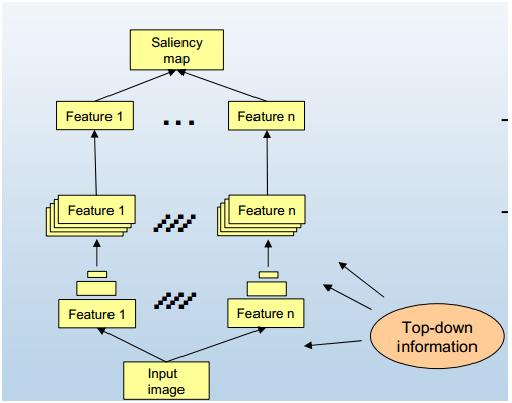Computational Visual
Attention Systems (CVAS ) have gained a lot of interest during the last years.
Similar to the human visual system, VSAS detect regions of interest in images:
by “directing attention” to these regions, they restrict further processing to
sub-regions of the image. Such guiding mechanisms are urgently needed, since
the amount of information available in an image is so large that even the most
performant computer cannot carry out exhaustive search on the data.
Psychologists, neurobiologists, and computer scientists have investigated
visual attention thoroughly during the last decades and profited considerably
from each other. However, the interdisciplinary of the topic holds not only
benefits but also difficulties.
This seminar provides
an extensive survey of the grounding psychological and biological research on
visual attention as well as the current state of the art of computational
systems. It includes basic theories and models like Feature Integration
Theory(FIT model) and Guided Search Model(GSM).A Real time Computational Visual
Attention System VOCUS (Visual Object detection with a Computational attention
System) is also included. Furthermore, presents a broad range of applications
of computational attention systems in fields like computer vision, cognitive
systems, and mobile robotics.
Evolution has favored
the concepts of selective attention because of the human need to deal with a
high amount of sensory input at each moment. This amount of data is, in
general, too high to be completely processed in detail and the possible actions
at one and the same time are restricted; the brain has to prioritize. The same
problem is faced by many modern technical systems. Computer vision systems have
to deal with thousands, sometimes millions, of pixel values from each frame and
the computational complexity of many problems related to the interpretation of
image data is very high .The task becomes especially difficult if a system has
to operate in real time. Application areas in which real-time performance is
essential are cognitive systems and mobile robotics, since the systems have to
react to their environment instantaneously. Computational attention systems
compute different features like intensity, color, and orientations in parallel
to detect feature dependent saliencies.
Every stage director is aware of the
concepts of human selective attention and knows how to exploit them to
manipulate his audience: A sudden spotlight illuminating a person in the dark,
a motionless character starting to move suddenly, a voice from a character
hidden in the audience, these effects not only keep our interest alive, but
they also guide our gaze, telling where the current action takes place. The
mechanism in the brain that determines which part of the multitude of sensory
data is currently of most interest is called selective attention. This concept
exists for each of our senses; for example, the cocktail party effect is well
known in the field of auditory attention. Although a room may be full of
different voices and sounds, it is possible to voluntarily concentrate on the
voice of a certain person. Before going in detail about Computational Visual
Attention Systems, we must have an idea about Human Visual System.
Limitations
In the field of
computational systems, and applications, there are still many open questions
One important question is, which are the optimal features of attention and how
these features interact?. Although intensively studied, this question is still
not fully answered. Another one is related with the interaction of different
features. Most of the systems computes
only the local saliencies. The investigation of visual perception in dynamic
scenes still remains as a challenging area. There is no idea about the amount
of learning involved in the visual search and the money and memory used for
these mechanisms.
This seminar gives a
broad overview of computational visual attention systems and their cognitive foundations and aims to
bridge the gap between different research areas (psychological and biological
research areas). Visual attention is a highly interdisciplinary field and the
disciplines investigate the area from different perspectives. Psychologists
usually investigate human behavior on special tasks to understand the internal processes of the brain, often
resulting in psychophysical theories or models. Neurobiologists take a view
directly into the brain with new techniques such as functional Magnetic
Resonance Imaging (fMRI). These methods visualize which brain areas are active
under certain conditions. Computer scientists use the findings from psychology and biology to build improved
technical systems.
In this seminar we discussed about the most
influential theories and models in the field of CVAS (FIT, GSM) and also method
for further improving the general performance of a computational visual
attention system by a typical factor of 10. The
method uses integral images for the feature computations and reduces the
number of necessary pixel accesses significantly, since it enables the
computation of arbitrarily sized feature values in constant time. In contrast
to other optimizations which approximate the feature values, this method is
accurate and provides the same results as the filter-based methods. The computation of regions of
interest can now be performed in real time for reasonable initial image
resolutions (half VGA) and thus allow their use in a variety of applications.
Attention can now be used for feature tracking or for reselecting landmark
features for visual SLAM. Computational attention has gained significantly in
popularity over the last decade. First
of all, adequate computational resources are now available to study attentional
mechanisms with a high degree of fidelity.

0 comments: